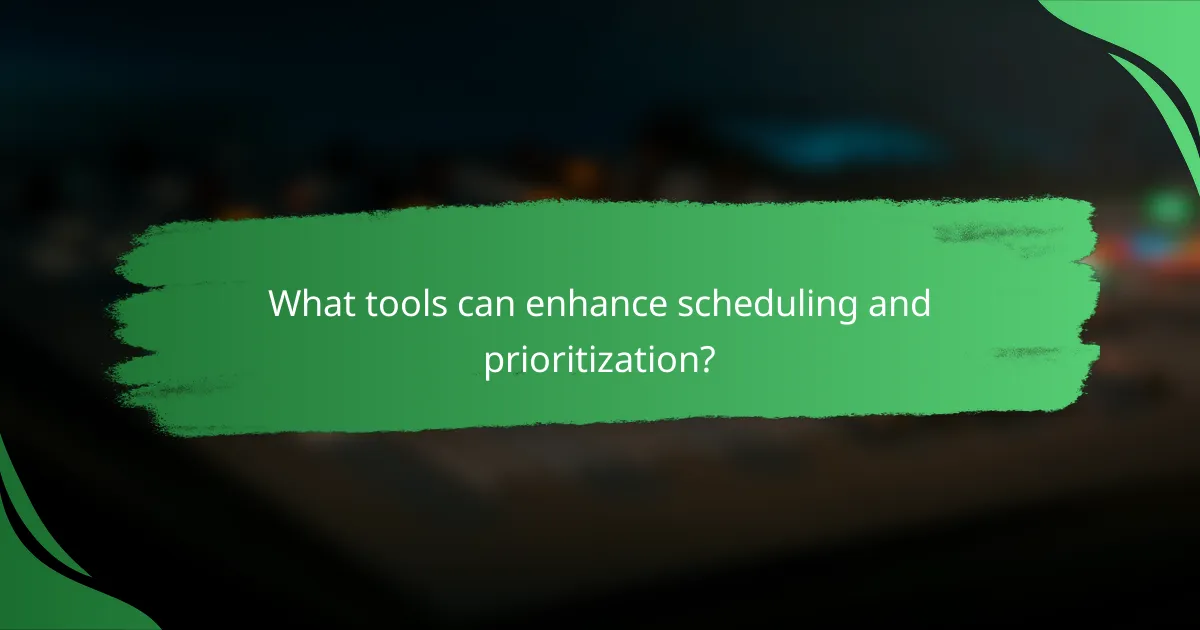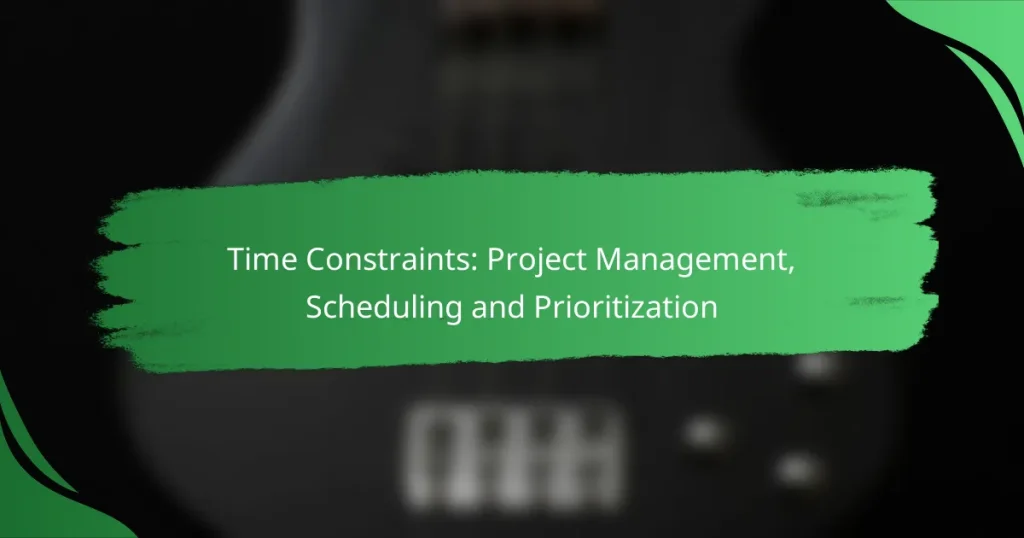Time constraints in project management require a delicate balance between deadlines, resource availability, and task complexity. By implementing structured scheduling techniques and prioritization methods, teams can enhance productivity and ensure that projects are completed on time, even under pressure.

How to manage time constraints in project management?
Managing time constraints in project management involves effectively balancing deadlines with resource availability and task complexity. By employing structured approaches, teams can enhance productivity and ensure timely project completion.
Utilize project management software
Project management software streamlines task assignment, scheduling, and communication among team members. Tools like Trello, Asana, or Microsoft Project can help visualize timelines and track progress, making it easier to identify potential delays.
When selecting software, consider features such as Gantt charts, collaboration tools, and reporting capabilities. Ensure that the chosen platform aligns with your team’s workflow to maximize efficiency.
Implement Agile methodologies
Agile methodologies, such as Scrum or Kanban, focus on iterative progress and flexibility. These approaches allow teams to adapt to changing requirements and prioritize tasks based on immediate needs, which is crucial when facing tight deadlines.
By breaking projects into smaller, manageable sprints, teams can regularly assess their progress and make necessary adjustments. This adaptability can significantly reduce the impact of unforeseen challenges on project timelines.
Set clear deadlines
Establishing clear deadlines is essential for maintaining focus and accountability within the team. Deadlines should be realistic, taking into account the complexity of tasks and available resources.
Consider using the SMART criteria—Specific, Measurable, Achievable, Relevant, Time-bound—to define deadlines. This approach helps ensure that all team members understand their responsibilities and the importance of timely completion.
Prioritize tasks effectively
Effective task prioritization is key to managing time constraints. Use methods like the Eisenhower Matrix to categorize tasks based on urgency and importance, which helps in focusing on what truly matters.
Regularly reassess priorities as project dynamics change. This ensures that the team remains aligned with project goals and can quickly pivot when necessary, avoiding bottlenecks.
Conduct regular progress reviews
Regular progress reviews help teams stay on track and identify potential issues early. Schedule brief check-ins or retrospectives to discuss accomplishments, challenges, and next steps.
These reviews foster open communication and collaboration, allowing team members to share insights and adjust plans as needed. Aim for weekly or bi-weekly reviews to maintain momentum and accountability throughout the project lifecycle.

What are effective scheduling techniques?
Effective scheduling techniques help project managers allocate resources and time efficiently, ensuring that tasks are completed on schedule. These methods enhance clarity, prioritize tasks, and improve overall productivity.
Use Gantt charts for visualization
Gantt charts are visual tools that display project timelines, showing tasks along a horizontal timeline. They help in tracking progress and understanding dependencies between tasks, making it easier to identify potential delays.
To create a Gantt chart, list all tasks, their start and end dates, and any dependencies. Software options like Microsoft Project or online tools such as Trello can simplify this process. Regularly updating the chart ensures that all team members are aligned on project status.
Apply the Eisenhower Matrix
The Eisenhower Matrix is a prioritization tool that categorizes tasks based on urgency and importance. It divides tasks into four quadrants: urgent and important, important but not urgent, urgent but not important, and neither urgent nor important.
By focusing on tasks that are both urgent and important, you can allocate your time effectively. Regularly reassess your tasks to ensure you are prioritizing correctly, which helps in avoiding burnout and improving productivity.
Adopt time-blocking strategies
Time-blocking involves scheduling specific blocks of time for different tasks or activities throughout your day. This technique minimizes distractions and helps maintain focus on the task at hand.
To implement time-blocking, allocate chunks of time for high-priority tasks and include breaks to recharge. For example, you might block two hours in the morning for deep work and an hour in the afternoon for meetings. This structured approach can significantly enhance your efficiency.
Incorporate buffer time
Buffer time refers to extra time added to your schedule to accommodate unexpected delays or additional tasks. Incorporating buffer time can prevent project overruns and reduce stress when unforeseen issues arise.
As a rule of thumb, consider adding 10-20% of the total task duration as buffer time. For instance, if a task is expected to take 5 hours, plan for 5.5 to 6 hours. This practice allows for flexibility and helps keep projects on track.

How to prioritize tasks under time constraints?
To prioritize tasks under time constraints, focus on distinguishing between urgent and important tasks, utilizing effective prioritization methods, and assessing available resources. This approach helps in maximizing productivity while meeting deadlines.
Identify urgent vs. important tasks
Understanding the difference between urgent and important tasks is crucial for effective prioritization. Urgent tasks require immediate attention, while important tasks contribute to long-term goals and values. A common framework is the Eisenhower Matrix, which categorizes tasks into four quadrants based on urgency and importance.
For example, a task like submitting a project report by the end of the day is urgent, whereas planning for a future project is important but not urgent. Focus on completing important tasks that align with your goals, even if they are not pressing.
Use the MoSCoW method
The MoSCoW method is a prioritization technique that categorizes tasks into four groups: Must have, Should have, Could have, and Won’t have. This method helps clarify what is essential and what can be deferred, especially under tight deadlines.
For instance, a “Must have” task might be completing a client deliverable due tomorrow, while a “Could have” task could be enhancing a feature that is not critical for the current release. Regularly review and adjust these categories as project needs evolve.
Assess resource availability
Evaluating resource availability is essential for effective task prioritization. Consider factors such as team capacity, skill sets, and available tools. Understanding who is available and what they can contribute helps in assigning tasks appropriately.
For example, if a team member has expertise in a specific area but is currently overloaded, it may be wise to reassign that task to someone with more availability. Regular check-ins can help keep track of resource status and adjust priorities as needed.

What tools can enhance scheduling and prioritization?
Effective scheduling and prioritization can be significantly improved with the right tools. These tools streamline task management, enhance team collaboration, and facilitate detailed project planning, making it easier to meet deadlines and allocate resources efficiently.
Trello for task management
Trello is a visual task management tool that uses boards, lists, and cards to organize tasks. It allows users to create boards for different projects, where tasks can be moved through various stages, such as “To Do,” “In Progress,” and “Done.” This visual approach helps teams quickly assess project status and prioritize tasks effectively.
To maximize Trello’s effectiveness, consider using labels for categorizing tasks, setting due dates, and integrating it with other tools like Slack or Google Drive for enhanced functionality. A common pitfall is overcrowding boards with too many tasks, which can lead to confusion; keeping lists concise helps maintain clarity.
Asana for team collaboration
Asana is designed for team collaboration, allowing members to assign tasks, set deadlines, and track project progress in real-time. Its user-friendly interface supports various views, including lists, boards, and timelines, making it adaptable to different team workflows. This flexibility is crucial for prioritizing tasks based on urgency and importance.
To get the most out of Asana, utilize its project templates for common workflows and take advantage of its reporting features to monitor team performance. Avoid creating too many projects, as this can dilute focus; instead, consolidate related tasks into fewer projects for better management.
Microsoft Project for detailed planning
Microsoft Project is a robust tool for detailed project planning, offering advanced features like Gantt charts, resource allocation, and critical path analysis. This tool is ideal for complex projects that require meticulous scheduling and prioritization, allowing project managers to visualize timelines and dependencies between tasks.
When using Microsoft Project, ensure to define clear milestones and regularly update task progress to keep the project on track. A common mistake is neglecting to adjust timelines based on resource availability, which can lead to delays; regularly reviewing and adjusting the plan is essential for success.

How to evaluate project timelines effectively?
Evaluating project timelines involves assessing the feasibility and accuracy of the planned schedule. This process ensures that deadlines are realistic and achievable, allowing for better resource allocation and risk management.
Conduct retrospective analysis
Retrospective analysis involves reviewing past projects to identify what worked well and what did not regarding timelines. This analysis can reveal patterns in scheduling, resource allocation, and task completion that inform future project planning.
When conducting a retrospective, gather data on previous projects, focusing on the actual time taken versus the estimated time. Look for common bottlenecks or delays, and consider factors such as team performance, external dependencies, and unforeseen challenges.
To make this analysis effective, create a checklist of key questions: What tasks consistently took longer than expected? Were there any recurring issues that caused delays? How did team dynamics impact the timeline? This reflection will help refine your approach to future project timelines.


